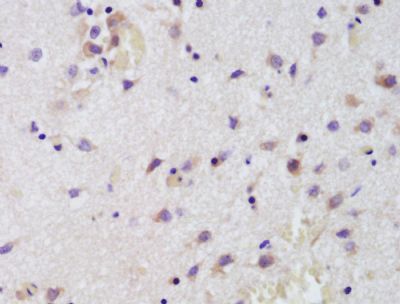FLRT3 is a 649 amino acid single-pass type I membrane protein that contains one fibronectin type-III domain and ten leucine-rich repeats and belongs to the fibronectin leucine rich transmembrane protein (FLRT) family. Expressed in heart, liver, lung, kidney, pancreas, brain, placenta and skeletal muscle, FLRT3 is thought to be involved in receptor signaling events and may play a role in both cell adhesion neurite outgrowth. Defects in the gene encoding mouse FLRT3 may lead to ventral closure, headfold fusion and endoderm migration defects, suggesting that FLRT3 is important for proper cell differentiation and development. FLRT3 exists as multiple alternatively spliced isoforms that are encoded by a gene which maps to human chromosome 20.
Function:
May have a function in cell adhesion and/or receptor signaling.
Subcellular Location:
Membrane; Single-pass type I membrane protein (Probable).
Tissue Specificity:
Expressed in kidney, brain, pancreas, skeletal muscle, lung, liver, placenta, and heart.
Similarity:
Contains 1 fibronectin type-III domain.
Contains 10 LRR (leucine-rich) repeats.
Contains 1 LRRCT domain.
Contains 1 LRRNT domain.
SWISS:
Q9NZU0
Gene ID:
23767
Database links:
Entrez Gene: 428552 Chicken
Entrez Gene: 23767 Human
Entrez Gene: 71436 Mouse
Entrez Gene: 366205 Rat
SwissProt: F1NUK7 Chicken
SwissProt: Q9NZU0 Human
SwissProt: B1H234 Rat
| Picture |
Sample:
Lane 1: Rat Cerebrum tissue lysates
Lane 2: Rat Lung tissue lysates
Primary: Anti-FLRT3 (SL12363R) at 1/1000 dilution
Secondary: IRDye800CW Goat Anti-Rabbit IgG at 1/20000 dilution
Predicted band size: 70 kDa
Observed band size: 73 kDa
Tissue/cell: rat brain tissue; 4% Paraformaldehyde-fixed and paraffin-embedded;
Antigen retrieval: citrate buffer ( 0.01M, pH 6.0 ), Boiling bathing for 15min; Block endogenous peroxidase by 3% Hydrogen peroxide for 30min; Blocking buffer (normal goat serum,SLC0005) at 37℃ for 20 min;
Incubation: Anti-FLRT3 Polyclonal Antibody, Unconjugated(SL12363R) 1:200, overnight at 4°C, followed by conjugation to the secondary antibody(SP-0023) and DAB(SLC0010) staining
|
|
|

